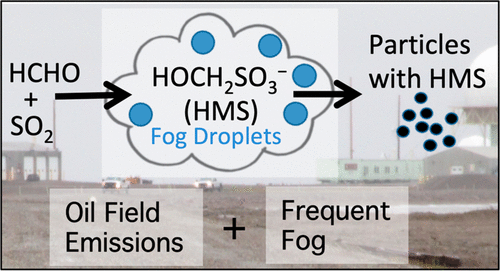当前位置:
X-MOL 学术
›
Environ. Sci. Technol. Lett.
›
论文详情
Our official English website, www.x-mol.net, welcomes your
feedback! (Note: you will need to create a separate account there.)
Hydroxymethanesulfonate (HMS) Formation during Summertime Fog in an Arctic Oil Field
Environmental Science & Technology Letters ( IF 8.9 ) Pub Date : 2021-06-28 , DOI: 10.1021/acs.estlett.1c00357 Jun Liu 1 , Matthew J. Gunsch 1 , Claire E. Moffett 2 , Lu Xu 3 , Rime El Asmar 4 , Qi Zhang 5 , Thomas B. Watson 6 , Hannah M. Allen 3 , John D. Crounse 7 , Jason St. Clair 8, 9 , Michelle Kim 7 , Paul O. Wennberg 3, 7 , Rodney J. Weber 4 , Rebecca J. Sheesley 2 , Kerri A. Pratt 1, 10
Environmental Science & Technology Letters ( IF 8.9 ) Pub Date : 2021-06-28 , DOI: 10.1021/acs.estlett.1c00357 Jun Liu 1 , Matthew J. Gunsch 1 , Claire E. Moffett 2 , Lu Xu 3 , Rime El Asmar 4 , Qi Zhang 5 , Thomas B. Watson 6 , Hannah M. Allen 3 , John D. Crounse 7 , Jason St. Clair 8, 9 , Michelle Kim 7 , Paul O. Wennberg 3, 7 , Rodney J. Weber 4 , Rebecca J. Sheesley 2 , Kerri A. Pratt 1, 10
Affiliation

|
Hydroxymethanesulfonate (HMS) is produced in the aqueous-phase reaction of formaldehyde (HCHO) and sulfur dioxide (SO2) and has been proposed as a significant contributor to midlatitude wintertime pollution events. Here we report HMS detection within submicrometer atmospheric aerosols during frequent late summer, regional fog events in an Arctic oil field. The number fraction of individual particles containing HMS increased during fog periods, consistent with aqueous-phase formation. The single-particle mass spectra showed the primary particle signature (oil field emissions), plus secondary oxidized organics and sulfate, consistent with aqueous-phase processing. HMS mass concentrations ranged from below the ion chromatography limit of detection (0.3 ng/m3) to 1.6 ng/m3, with sulfate concentrations of 37–222 ng/m3. HCHO and SO2 measurements suggest that the fog HMS production rate is ∼10 times higher in the oil fields than in the upwind Beaufort Sea. Aqueous-phase reactions of local oil field emissions during frequent summertime regional fog events likely have downwind impacts on Arctic aerosol composition. The potential for fog-based HMS production was estimated to be an order of magnitude higher in Fairbanks and Anchorage, AK, than in the oil fields and may explain the missing organosulfate source contributing to Fairbanks air quality.
中文翻译:

北极油田夏季雾中羟基甲磺酸盐(HMS)的形成
羟甲磺酸盐 (HMS) 在甲醛 (HCHO) 和二氧化硫 (SO 2 )的水相反应中产生,并被认为是造成中纬度冬季污染事件的重要因素。在这里,我们报告了在夏末频繁发生的北极油田区域雾事件中亚微米大气气溶胶内的 HMS 检测。在雾期间,含有 HMS 的单个颗粒的数量分数增加,与水相形成一致。单粒子质谱显示初级粒子特征(油田排放),加上次级氧化有机物和硫酸盐,与水相处理一致。HMS 质量浓度范围从低于离子色谱检测限 (0.3 ng/m 3 ) 到 1.6 ng/m 3,硫酸盐浓度为 37–222 ng/m 3。HCHO 和 SO 2测量表明,油田中的雾 HMS 生产速率比上风波弗特海的高约 10 倍。在频繁的夏季区域雾事件期间,当地油田排放物的水相反应可能对北极气溶胶成分产生顺风影响。据估计,费尔班克斯和阿拉斯加州安克雷奇的雾基 HMS 生产潜力比油田高一个数量级,这可能解释了导致费尔班克斯空气质量下降的有机硫酸盐来源。
更新日期:2021-07-13
中文翻译:

北极油田夏季雾中羟基甲磺酸盐(HMS)的形成
羟甲磺酸盐 (HMS) 在甲醛 (HCHO) 和二氧化硫 (SO 2 )的水相反应中产生,并被认为是造成中纬度冬季污染事件的重要因素。在这里,我们报告了在夏末频繁发生的北极油田区域雾事件中亚微米大气气溶胶内的 HMS 检测。在雾期间,含有 HMS 的单个颗粒的数量分数增加,与水相形成一致。单粒子质谱显示初级粒子特征(油田排放),加上次级氧化有机物和硫酸盐,与水相处理一致。HMS 质量浓度范围从低于离子色谱检测限 (0.3 ng/m 3 ) 到 1.6 ng/m 3,硫酸盐浓度为 37–222 ng/m 3。HCHO 和 SO 2测量表明,油田中的雾 HMS 生产速率比上风波弗特海的高约 10 倍。在频繁的夏季区域雾事件期间,当地油田排放物的水相反应可能对北极气溶胶成分产生顺风影响。据估计,费尔班克斯和阿拉斯加州安克雷奇的雾基 HMS 生产潜力比油田高一个数量级,这可能解释了导致费尔班克斯空气质量下降的有机硫酸盐来源。











































 京公网安备 11010802027423号
京公网安备 11010802027423号